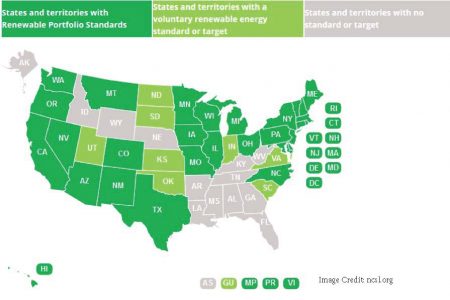“We are like tenant farmers, chopping down the fence around our house for fuel, when we should be using nature’s inexhaustible sources of energy—sun, wind, and tide.” Thomas Edison in 1931, as quoted by James D. Newton
On November 26th, 2019, the United Nations Environment Program released its Emissions Gap Report 2019. The gap the report describes is the one between where greenhouse gas (GHG) emissions are, where they are headed, and where they need to be to maintain a stable and safe climate.
In a nutshell, the gap is way too big and it is growing. According to the report, global temperatures could rise as much as 3.9 degrees Celsius, or 7 degrees Fahrenheit, by the end of the century. The internationally stated goal for global temperature rise is 1.5 degrees C, or 2.7 degrees F. The stated absolute upper limit of temperature increase that we can reasonably tolerate is 2.0 degrees C, or 3.6 degrees F.
Areas in the northern latitudes have already seen temperature increases above 2.0 degrees C.
Accompanying the report was a statement released by Inger Andersen, executive director of the U.N. Environment Program. In part, that statement reads: “Our collective failure to act early and hard on climate change means we now must deliver deep cuts to emissions. We need to catch up on the years in which we procrastinated.”
So now what? I have written before about Project Drawdown, which identifies the top 100 solutions to global warming. Project Drawdown’s research discovered that humanity is already doing – on a small scale – everything we need to do to reverse global warming and draw down GHG concentrations to a safe level. We just have to dramatically and quickly scale up what we already know how to do. Viewed through this lens, Project Drawdown sees the climate crisis to be an opportunity to do things differently and in the process restore a safe and stable climate while creating millions of new and sustainable jobs.
Several ready-made solutions identified by Project Drawdown relate to solar energy. At least three of them present great opportunities here in Alabama.
One is building more large-scale, or utility-scale, solar farms for large-scale energy users like Auburn University. According to Drawdown: “When their entire life cycle is taken into account, solar farms curtail 94 percent of the carbon emissions that coal plants emit and completely eliminate emissions of sulfur and nitrous oxides, mercury, and particulates….Currently .4 percent of global electricity generation, utility-scale solar PV grows to 10 percent (by 2050) in our analysis…. That increase could avoid 36.9 gigatons (36.9 billion tons) of carbon dioxide emissions, while saving $5 trillion in operational costs…—the financial impact of producing energy without fuel.” And solar energy has become very inexpensive. Wow!
Another solar solution is rooftop solar for homes and small businesses. If rooftop solar deployment can grow to 7 percent of global electricity generation by 2050, a reasonable expectation, that would reduce GHG emissions by 24.6 gigatons. It would cost $453.14 billion to implement and save $3.46 trillion net operational savings. Wow!
Solar thermal, or solar water heating, is a third solution. According to Drawdown, heating water consumes 25 percent of home energy use and 12 percent of energy use in commercial buildings. This simple technology has been around for a long time and can be easily installed. Drawdown’s impact assessment: “If solar water heating grows from 5.5 percent of the addressable market to 25 percent, the technology can deliver emissions reductions of 6.1 gigatons of carbon dioxide and save households $774 billion in energy costs by 2050. In our calculations of up-front costs, we assume solar water heaters supplement and do not replace electric and gas boilers.” Wow!
The Southern Environmental Law Center reports that Alabama ranks 13th nationally in raw solar energy potential, and 8th in potential economic benefit from solar generation of electricity.
What are we waiting for? Thomas Edison saw the future nearly 90 years ago.
By developing state policies that facilitate the rapid development of unlimited, pollution-free solar energy we can do our part as Alabamians to reduce emissions now, and in the process reap significant economic benefits in terms of lower energy costs and substantial job growth.
One important step is for Alabama to establish renewable energy portfolio standards, something a majority of states have already done. From a November 1, 2019 post at the National Conference of State Legislatures website:
States have been very active in the past year revising their Renewable Portfolio Standards (RPS), which require that a specified percentage of the electricity that utilities sell comes from renewable resources. States have created these standards to diversify their energy resources, promote domestic energy production and encourage economic development. Renewable energy policies help drive the nation’s $64 billion market for wind, solar and other renewable energy sources. These policies can play an integral role in state efforts to diversify their energy mix, promote economic development and reduce emissions. Roughly half of the growth in U.S. renewable energy generation since 2000 can be attributed to state renewable energy requirements.
Twenty-nine states, the District of Columbia, and three territories have established RPS. Eight states have established voluntary renewable energy goals. Alabama is one of only twelve states that have neither renewable standards nor voluntary goals.
 The Yale Program on Climate Change Communication conducts opinion surveys on climate change and renewable energy and maps the results. The September 19, 2019, Climate Opinion Map for Alabama reveals that at least half of Alabamians want the governor and local officials to do more to address global warming and a majority of Alabamians support the state requiring utilities to produce 20% of the electricity they generate from renewable sources.
The Yale Program on Climate Change Communication conducts opinion surveys on climate change and renewable energy and maps the results. The September 19, 2019, Climate Opinion Map for Alabama reveals that at least half of Alabamians want the governor and local officials to do more to address global warming and a majority of Alabamians support the state requiring utilities to produce 20% of the electricity they generate from renewable sources.
Again I ask, what are we waiting for? As climate science makes clear, we need to act quickly and on a large scale. Making the transition to utility-scale and rooftop solar energy will help us do what we must to address the climate crisis while, as the National Conference on State Legislatures says, diversifying our energy resources, promoting domestic energy production, and encouraging economic development.
Learn about the SDGs & AU and our contributions related to this post.






Regrettably, far too many folks are awaiting measures such as the use of solor power by their neighbors prior to acting themselves. We’re in a waiting game stand-off with little environmental leadership coming from elected officials.